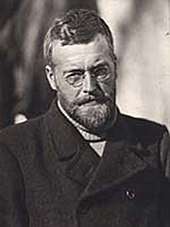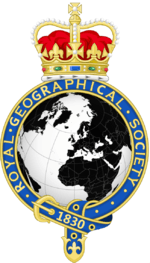James Wordie
Sir James Mann Wordie CBE [[Fellow of the Royal Society PRGS FRSGS LLD (26 April 1889 – 16 January 1962) was a Scottish polar explorer and geologist. Friends knew him as Jock Wordie.

He was President of the Royal Geological Society from 1951 to 1954.[1]
Wordie was born at Partick, Glasgow, the son of John Wordie, owner of Wordie & Co, a major carrier and carting contractor, with multiple premises throughout Glasgow, and Jane Catherine Mann. The family lived at 4 Buckingham Terrace in the Hillhead district.[2] The house (which still exists) is a fine mid-terraced 19th century three storey and basement house facing the Great Western Road.
James studied at Glasgow Academy then studied Sciences at Glasgow University, obtaining a BSc in Geology in 1910.[3] He then won a place at Cambridge University where he undertook a master's degree at St John's College gaining an MA in 1912, then began research work. His occupation brought him in contact with Frank Debenham and Raymond Priestley, who were members of the second Antarctic expedition of Robert Falcon
Polar exploration
In 1914, Wordie joined Sir Ernest Shackleton's expedition to the Antarctic, known as the Imperial Trans-Antarctic Expedition, where he acted as geologist and chief of scientific staff. Despite the overall failure of the expedition—including the beset ship Endurance, caught up in the Weddell Sea until destroyed by ice in 1915—Wordie maintained the morale of the expedition, made scientific observations regarding oceanography and the ice pack, and acquired important geological specimens.
He was conscripted into the army on return to Britain (the First World War being at its height) and served with the Royal Artillery in France 1917 to 1918.[1]
He was awarded the Royal Geographical Society's Back Award in 1920.
Wordie sailed on nine polar expeditions, including Endurance. During the 1920s and 1930s, he made numerous voyages to the Arctic and helped nurture a new generation of young explorers, including Vivian Fuchs, Gino Watkins and Augustine Courtauld. Other scientific staff included the meteorologist Edmund Dymond on his 1937 research trip to Baffin Bay. He became the elder statesman of British polar exploration, and few expeditions left Britain without first consulting Wordie. The Wordie Ice Shelf on the Antarctic Peninsula was named in his honour.
In the Second World War he served with Naval Intelligence.
He was chairman of the Scott Polar Research Institute (SPRI) and president of the Royal Geographical Society from 1951 to 1954. During his term at the Society he helped plan the first successful ascent of Mount Everest by Edmund Hillary and Tenzing Norgay. While at SPRI, he assisted Fuchs in the first-ever crossing of the Antarctic continent — the original aim of Shackleton's Endurance expedition. He also contributed to the British Naval Intelligence Division Geographical Handbook Series that was published during the Second World War.
Final years
Both the University of Glasgow and University of Hull awarded him honorary doctorates (LLD).
He died at Grange Court on Grange Road in Cambridge on 16 January 1962. He is buried in the churchyard of the Church of the Holy Rude in Stirling in central Scotland.[4]
Family
He was married to Gertrude Henderson in 1923.
Recognition
Wordie was elected a Fellow of the Royal Society of Edinburgh in 1922. His proposers were Frederick Orpen Bower, Andrew Gray, James Gordon Gray and James Currie.[1]
He was awarded the first W. S. Bruce Medal of the Royal Scottish Geographical Society in 1926,[5] the Founder's Gold Medal of the Royal Geographical Society in 1933[6] and the Scottish Geographical Medal of the Royal Scottish Geographical Society in 1944. He was made Master of St John's College, Cambridge and in 1957 was knighted (KBE) by King George VI for his contributions to polar expeditions.
The Wordiekammen Limestone and Wordie Creek Formation were named in his honour. Places named after him include Mount Wordie, Wordie Point, Wordie Bay, Wordie Bay (Greenland), Wordie Seamount, Wordie Ice Shelf, Wordie Glacier, Wordie Nunatak and Point Wordie.
References
- Biographical Index of Former Fellows of the Royal Society of Edinburgh 1783–2002 (PDF). The Royal Society of Edinburgh. July 2006. ISBN 978-0-902198-84-5.
- Glasgow Post office Directory 1889
- "University of Glasgow :: Story :: Biography of Sir James Mann Wordie". www.universitystory.gla.ac.uk. Retrieved 17 February 2020.
- "James Mann "Jock" Wordie (1889-1962) - Find A Grave-gedenkplek". Retrieved 17 February 2020.
- "W S Bruce Medal". Royal Scottish Geographic Society. Archived from the original on 14 July 2018. Retrieved 20 October 2016.
- "List of Past Gold Medal Winners" (PDF). Royal Geographical Society. Archived from the original (PDF) on 27 September 2011. Retrieved 24 August 2015.
- Farmer, B. H. (2004). "Wordie, Sir James Mann (1889–1962)", rev., Oxford Dictionary of National Biography: Oxford University Press. Accessed 8 September 2006 (subscription required).
- Smith, Michael (2004). Polar Crusader: Sir James Wordie – Exploring the Arctic and Antarctic: Birlinn. ISBN 1-84158-292-1.
| Academic offices | ||
|---|---|---|
| Preceded by Ernest Alfred Benians |
Master of St John's College, Cambridge 1952–1959 |
Succeeded by J. S. Boys Smith |
